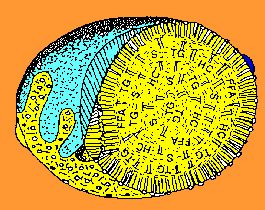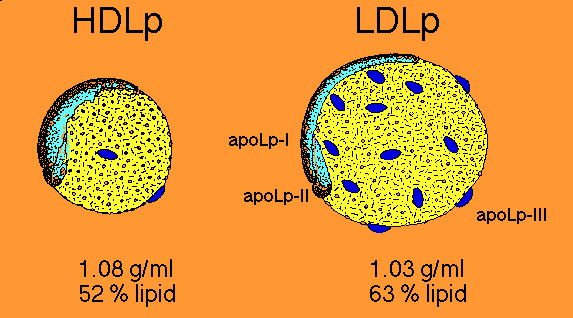

Since lipids are not readily soluble in aqueous media, they are normally transported together with protein components. The resulting lipoproteins are composed of the lipid components (mostly buried within the lipoprotein) and a number of apolipoproteins; in these amphiphilic proteins, the hydrophobic residues face the lipid core of the lipoprotein, while the hydrophilic side is facing the aqueous medium .

Fig. 1: Model of lipoproteins showing the arrangement of lipid and protein moieties
Proteins usually have a density of >1.3 g/ml. Since lipids have a lower density than water (oil floats on the surface), the density of lipoproteins depends on the ratio of lipid to protein. Lipoproteins are therefore classified according to their density.
| Lipoprotein | full name | density |
|---|---|---|
| VLDL | very low density lipoprotein | <1.006 g/ml |
| LDL | low density lipoprotein | 1.006-1.062 g/ml |
| HDL | high density lipoprotein | 1.063-1.20 g/ml |
| VHDL | very high density lipoprotein | >1.20 g/ml |
The density not only depends on the overall amount of lipid, but also on the relative amounts of the different lipid classes. For example, phospholipids have a higher density than the neutral glycerides, and thus lipoproteins rich in phospholipids have a higher density than proteins that contain mostly di-and triglycerides.
The characteristic densities of lipoproteins are frequently used for the rapid isolation of lipoproteins by density gradient centrifugation. If a lipoprotein is placed into a density gradient, it floats (or sediments) to the zone of identical density. Since diffusion counteracts sedimentation by gravity, higher g-forces than gravity are applied to the protein solution. In practice, forces of more than 100,000 x g are required and can be achieved by ultracentrifugation.
In this experiment, we will isolate a lipoprotein from locust
hemolymph (= blood). The major insect lipoprotein is called lipophorin,
which is derived from the Greek language and means "carrier
of fats":![]()
It is composed of three apolipoproteins ( Fig 1 ):
| Lipophorin apoproteins | ||
|---|---|---|
| apoprotein | full name | Molecular weight |
| apoLp-I | apolipophorin I | 250,000 Daltons |
| apoLp-II | apolipophorin II | 80,000 Daltons |
| apoLp-III | apolipophorin III | 18,000 Daltons |
In contrast to mammalian lipoproteins, the lipid content and thus the density of lipophorin can change. In resting insects, the main protein is high density lipoprotein (HDLp, density ~ 1.08 g/ml). During flight, however, when insects require lipids to fuel extended muscle activity, lipid is released from reserves and picked up by HDLp, which changes its density accordingly. The resulting particle is called low density lipophorin (LDLp, density 1.03 g/ml). Since much of the lipid is loaded to the outside of the HDLp particle, additional protein components are necessary to shield the lipid surface from the aqueous surroundings. This is achieved by several apoLp-III molecules (Fig. 2).

Fig 2: Models of HDLp and LDLp showing apoLp-I, II and III molecules
At the muscle, apoLp-III and lipid is released, resulting again in an HDLp particle. This ingenious "re-usable shuttle" concept is illustrated in Figure 3. Lipid release from the fat body is induced by a hormone (adipokinetic hormone; AKH) that is released after the initiation of flight. We will inject this hormone into one group of insects and compare the resulting lipoproteins.

Fig. 3: Lipid " re-usable shuttle"
During the first week, you will bleed locusts and isolate the lipoprotein by density gradient centrifugation. In the second week, the protein components will be analyzed by SDS electrophoresis. In the third week, the gels will be analyzed in order to determine the subunit structure of the protein.
In addition, you will have to extract the lipid components from a known amount of desalted, freeze dried lipoprotein, for quantification and analysis in the following experiment (Lipid analysis).